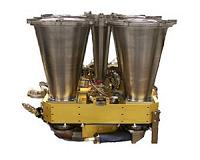 |
Laurel MD (SPX) May 09, 2011 MESSENGER has completed its 100th orbit around Mercury. Since its insertion into orbit about the innermost planet on March 17, the spacecraft has executed nearly 2 million commands. The data gathered so far include more than 70 million magnetic field measurements, 300,000 visible and infrared spectra of the surface, 16,000 images, and 12,000 X-ray and 9,000 gamma-ray spectra probing the elemental composition of Mercury's uppermost crust. "As the primary orbital phase of the MESSENGER mission unfolds, we are building up the first comprehensive view of the innermost planet," states MESSENGER Principal Investigator Sean Solomon, of the Carnegie Institution of Washington. "The surface is unraveling before our eyes in great detail, and the planet's topography and gravity and magnetic fields are being steadily filled in. As the Sun becomes increasingly active, Mercury's extraordinarily dynamic exosphere and magnetosphere continue to display novel phenomena." MESSENGER continues its science-mapping phase in orbit around Mercury. All spacecraft systems remain safe and healthy, and all science instruments are on and continue to collect data according to the baseline observation plan. "Over the next several weeks, MESSENGER's subsystems and instruments will experience their hottest temperatures yet as the spacecraft crosses between the planet's surface and our Sun at high noon close to the planet, preceded by hour-long eclipses near local midnight with only the spacecraft battery to keep the spacecraft alive in the dark of Mercury's night," notes MESSENGER Project Scientist Ralph McNutt. "All of this was planned in great detail more than seven years ago, as was the orbit insertion burn that went so flawlessly," he adds. "Theory is one thing and reality another, and the sense of thrill leading to 'firsts' is always followed by a sense of relief, especially in the challenging environment of interplanetary space, far from home." With less than one-sixth of its primary orbital mission completed, MESSENGER is already rewriting our books on what is known (and unknown) regarding the innermost planet, McNutt says. "By exploring our near - and far - neighbors in our solar system, we touch new knowledge, new understanding, and new wonderment about not only our own origins and place but of the other worlds circling the stars we see in our night sky."
Share This Article With Planet Earth
Related Links MESSENGER News Flash at Mercury Mars News and Information at MarsDaily.com Lunar Dreams and more
 Profiling Polar Craters with the Mercury Laser Altimeter
Profiling Polar Craters with the Mercury Laser AltimeterBaltimore MD (SPX) Apr 28, 2011 MESSENGER's Mercury Laser Altimeter (MLA) uses a laser to measure the distance from the spacecraft to Mercury's surface. The instrument sends a laser pulse to Mercury and measures the time it takes the light to bounce off the surface and return. Because we know the speed of light, we can convert the round-trip time to distance. Because we know the positions of the MESSENGER spacecraft and Mercur ... read more |
|
| The content herein, unless otherwise known to be public domain, are Copyright 1995-2010 - SpaceDaily. AFP and UPI Wire Stories are copyright Agence France-Presse and United Press International. ESA Portal Reports are copyright European Space Agency. All NASA sourced material is public domain. Additional copyrights may apply in whole or part to other bona fide parties. Advertising does not imply endorsement,agreement or approval of any opinions, statements or information provided by SpaceDaily on any Web page published or hosted by SpaceDaily. Privacy Statement |